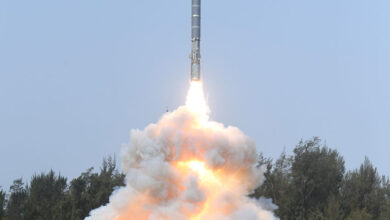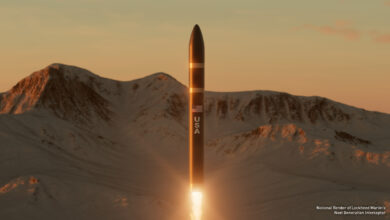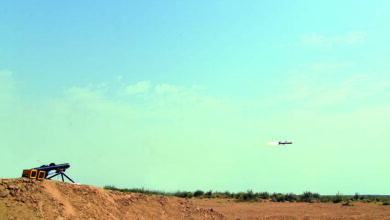India Fails to get MTCR Membership, But Wins Wide Support
New Delhi. India failed in its maiden attempt this October to win consensus support for its entry to the Missile Technology Control Regime (MTCR).
But, inspiring hope for India, the outgoing Norwegian Chairman of the grouping, Ambassador Roald Næss, tweeted after the meeting concluded on October 9: “Broad support for Indian membership in MTCR, but regrettably no consensus yet. I remain optimistic.†The 34-member voluntary grouping ended its 29th annual session in the port city of Rotterdam in Holland that day without any decision on India’s application for membership.
India had formally submitted an application in June 2015 with active support from the US and France.
Details of the MTCR plenary, held October 5 – 9, were not disclosed but there are indications that Italy, peeved over the prolonged trial of two of its marines in India in a shooting case, asked for time, and simply abstained. There was no confirmation though.
However, authoritative US diplomatic sources told India Strategic that Washington was doing what it could, and India’s entry into the elite missile denial regime was “imminent,†possibly within a couple of months through a special session. “India doesn’t have to wait for the plenary next October,†it was stated.
Indian Ministry of External Affairs (MEA) spokesperson Vikas Swarup observed that India’s application was “received well and it remains under consideration†but chose to offer no details.
Thanks to the friendship that Indian Prime Minister Narendra Modi and President Barack Obama have built in the recent months, it looks like that Washington has taken upon itself to steer New Delhi’s entry into both the MTCR and Nuclear Suppliers Group (NSG). The latter was ironically set by the US against India after its 1974 nuclear test.
While entry into the MTCR is certain, the gateway to the NSG may be laced with hurdles as China is seeking similar status for Pakistan, despite Islamabad’s persistent and consistent record in both nuclear and missile proliferation. China is not a member of MTCR, and Italy doesn’t have any reservation against India on proliferation. Its abstention at the MTCR meeting was just a diplomatic nudge to New Delhi to let go its marines, who had shot two Indian fishermen allegedly suspecting them to be terrorists. The marines were guarding a ship against piracy.
How New Delhi negotiates with Beijing is to be seen, but diplomats at the MEA will have to work hand in hand with their counterparts from there as well as those from Washington, Paris, Moscow, London and other capitals. Barring a few border incidents, both India and China have maintained peace, their bilateral trade has been growing, and significantly, there is some interaction between their armed forces.
A bilateral army exercise between them at the Kunming Military Academy in Yunnan, held October 12 – 21, was aptly named Hand-in-Hand. Nonetheless, diplomacy has its own price tags, and China is bound to demand favours for Pakistan, its only military ally besides North Korea. (The latter though is best described as a dependency of China).
Notably, while an odd country may still oppose India’s attempts to join the denial regimes, there is considerable victory for India insofar as most of their members have come to appreciate New Delhi’s persistent non proliferation policies regarding nuclear weapons and missiles.
Although India was The Target of some of these denial regimes right after its first nuclear test in 1974, New Delhi indicated its willingness to join them after its second nuclear tests in 1998. In April 2012, the then Foreign Secretary Ranjan Mathai told strategic experts at the Institute for Defence Studies and Analyses (IDSA) in New Delhi that it was time for India to join these four regimes, beginning with the NSG.
This was the first formal, and categorical, move by India, and ever since, diplomats handling disarmament at the Ministry of External Affairs (MEA) have successfully engaged various capitals.
Significantly now, Washington is supporting India’s entry into all the four denial regimes, that is, MTCR, NSG, the Wassenaar Arrangement and Australia Group. Indian diplomats are working hard towards the first two regimes; the remaining two will automatically happen thereafter.
It also doesn’t matter whether India gets into the MTCR first, or the NSG. But it looks like that MTCR may happen within 2015, and NSG, sometime next year. Entry into either the MTCR or NSG will be a landmark development for India, opening doors to trade in high technology systems like cryogenic rockets, so urgently required for the country’s space programme.
India is also looking forward to membership of the UN Security Council (UNSC).
I recall Prime Minister Indira Gandhi telling me in an informal chat that India deserved to be in the UN Security Council (UNSC), and that India’s nuclear test in 1974 was as much aimed at deterrence as much at this high table in New York. The US has come around to this also, and during his recent visit to the US, Prime Minister Narendra Modi disclosed that President Obama had promised him full support in this regard.
This is indeed a big deal, and a success of Mr Modi’s diplomacy of warmth and friendly demeanor.
I may mention that as a young reporter for UNI news agency then, I had the privilege of breaking news of India’s nuclear test, and giving details like its location and the first international reaction in Canada withdrawing nuclear assistance to India within 10 days of the earth-shaking explosion.
MTCR was set up in April 1987 by seven countries, namely Canada, Germany, France, Japan, Italy, Britain and the United States, to check proliferation of ballistic missiles with over 300 km range and 500kg of bomb payload. In 1992, Unmanned Aerial Vehicles (UAVs) that can deliver Weapons of Mass Destruction (WMDs) were included, and later, even software for such delivery systems was covered.
India hasn’t signed any of the denial regimes but has voluntarily adhered to them. The BrahMos supersonic cruise missile for instance, which India makes in collaboration with Russia, adheres to the MTCR ambit.
India has steadily maintained a clean record, and as Mr Mathai had pointed out three years ago: India has “a law based export system, covering about nine different legislations,†and that “the nation’s export controls are in line with the highest international standards.â€
It may be recalled that although Mrs Indira Gandhi gave the go-ahead for the nuclear test, and also initiated the nuclear powered, nuclear attack capable submarines (SSBN) programme – that has culminated in today’s Arihant submarine – because of the perceived threat from China. But she chose not to translate the nuclear capability into hardware during her lifetime.
It was only in 1988 that the then Prime Minister Rajiv Gandhi gave the go-ahead for nuclear weapons after India’s external intelligence agency, RAW, informed him that Pakistan had already done so. The inputs were shared with Washington, where unfortunately, the presidency of George HW Bush ignored them till the CIA finally had to admit before the US Congress that Islamabad had indeed developed nuclear weapons. A retired Pakistani brigadier was also apprehended in the US for trying to smuggle nuclear weapon triggers (krytrons) to Pakistan.
Meanwhile, MTCR’s Chair has passed from Norway to Luxembourg and Netherlands, on whose behalf Dutch Ambassador Piet de Klerk presided over the meeting in Rotterdam. He will continue till October 2016.
Foreign Ministers Jean Asselborn (Luxembourg) and Bert Koenders (Holland) welcomed the participants.
According to a statement issued after the 5-day MTCR meeting from October 5, “The main purpose of the Plenary Meeting was to review and evaluate the MTCR’s activities over the last 12 months and to intensify the efforts of MTCR Partners to prevent the proliferation of unmanned delivery systems capable of delivering weapons of mass destruction (WMD).â€
“MTCR Partners – as the members are described – recalled that the proliferation of WMD (nuclear, chemical and biological weapons) and their means of delivery remains a threat to international peace and security, as recognised in UN Security Council Resolution 1540. They reiterated their commitment to limit the risks of proliferation by controlling international transfers that can contribute to delivery systems for WMD. They held a thorough exchange of information on missile proliferation developments since their last Plenary Meeting in Oslo.
“Partners welcomed that the MTCR Guidelines and control lists in the Annex constitute an international best practices benchmark for controlling exports of missile-related items and technologies, and noted that these standards are increasingly adhered to by non-partners and are included in some UN Security Council resolutions.â€
Besides the seven who set up MTCR, the other members are: Argentina, Australia, Austria, Belgium, Bulgaria, Brazil, Czeck Republic, Denmark, Finland, Greece, Hungry, Iceland, Ireland, Luxembourg, Netherlands, New Zealand, Norway, Poland, Portugal, South Korea, Russia, South Africa, Spain, Sweden, Switzerland, Turkey, and Ukraine.





